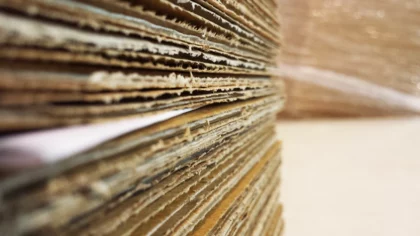Our Innovation Analysts recently looked into emerging technologies and up-and-coming startups working on solutions for the packaging sector. As there is a large number of startups working on a wide variety of solutions, we decided to share our insights with you. This time, we are taking a look at 5 promising thermal packaging solutions.
Heat Map: 5 Top Thermal Packaging Solutions
For our 5 top picks, we used a data-driven startup scouting approach to identify the most relevant solutions globally. The Global Startup Heat Map below highlights 5 interesting examples out of 106 relevant solutions. Depending on your specific needs, your top picks might look entirely different.
Omega Packaging – Expanded Polystyrene (EPS) Foam
EPS Foam has been in use for decades as it sufficiently addresses the lightweighting challenges and related cost-efficiency issues that the packaging industry faces. Nowadays though, manufacturers and researchers are working towards making EPS more recyclable and, thus, a more sustainable thermal packaging option.
The Australian company Omega Packaging designs and develops EPS foam boxes for food packaging that provide durable insulation and protection from temperature shifts, mechanical shocks, and microbes. Omega Packaging uses integrated molding technology and recycles used or defect EPS into general-purpose polystyrene.
Landpack – Plant Fibers
Plant fibers stand for one more economical thermal packaging variant but compared to Expanded Polystyrene Foam they are of natural origin. Based on hemp, flax, cotton or other natural fibers, plant-based insulation packaging supports eco-friendliness, maintains natural moisture regulation, does not contain any dangerous materials, and, in general, sustains decent thermal stability.
German startup Landpack creates biodegradable and compostable thermal packaging, based on hemp and straw to handle the logistics of produce. Landpack’s design, mediated by natural materials, nurtures thermal conductivity, ensures shock absorption, saves storage space, and is eligible for organic waste disposal.
Wool Cool – Animal Waste
Nowadays it becomes possible to turn animal waste materials into valuable thermal packaging. Thanks to their proven and natural thermo-balancing capabilities, wool, poultry feathers, camel hair, fleece, and other animal fibers become the renewable foundation for sustainable packaging options that are supposed to meet recyclability, biodegradability, and thermoregulation requirements.
The UK-based startup Wool Cool manufactures sustainable wool-based insulation packaging for food and pharmaceutical products. Acting as a natural thermostat, Wool Cool’s smart wool fibers regulate moisture and maintain required temperatures. Besides, the company’s boxes and liners are completely biodegradable and compostable.
Cellulose Material Solutions – PET Plastic
Due to the fact that recycled Polyethylene Terephthalate (PET) polymers possess remarkable electrical insulation capacities and are usually transformed into fibers, sheets and fabrics, they represent an excellent alternative for conventional EPS and Polyurethane. The range of use cases varies from simple box liners to complex roofing applications.
The US-based company Cellulose Material Solutions creates a thermal box liner, made of recycled PET plastic. The proprietary lightweight product structure contains no toxic substances, grants proper shocks protection and durable thermal performance.
Duugy – Mycelium
Mycelium packaging reduces the dependence on fossil fuels and petrochemicals by utilizing fungi to produce mycelium structures with decent binding and thermoregulation capabilities. It does not require colossal energy costs to manufacture and is flexible enough for customization.
Slovakian startup Duugy cultivates mushroom colonies in order to produce ecological, inflammable, and strong “fungipack” for thermal packaging. Thanks to a specific technology and mycelium lifecycle, Duugy molds raw materials into a variety of forms and textures to satisfy the needs of different industries.
What About The Other 101 Thermal Packaging Solutions?
While we believe data is key to creating insights it can be easy to be overwhelmed by it. Our ambition is to create a comprehensive overview and provide actionable innovation intelligence for your Proof of Concept (PoC), partnership, or investment targets. The 5 thermal packaging solutions showcased above are promising examples out of 106 we analyzed for this article. To identify the most relevant solutions based on your specific criteria and collaboration strategy, get in touch.




![Packaging 4.0 : Top 9 Digital Transformation Technologies to Watch [2025]](https://www.startus-insights.com/wp-content/uploads/2025/02/Packaging-4.0-SharedImg-StartUs-Insights-noresize-420x236.webp)




